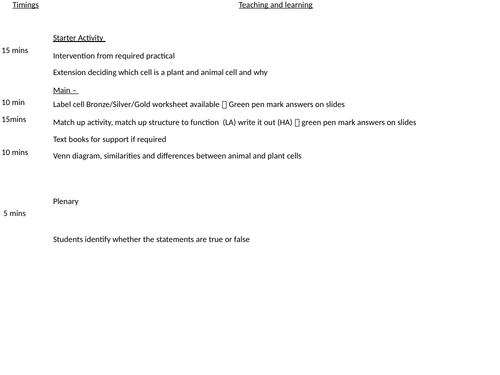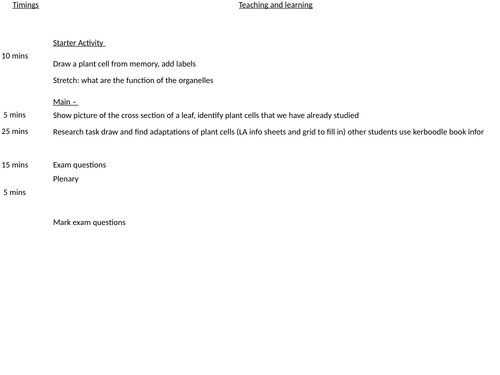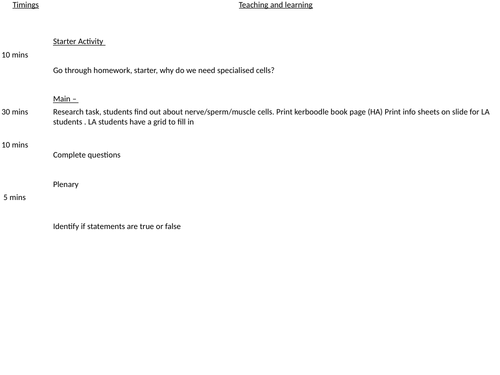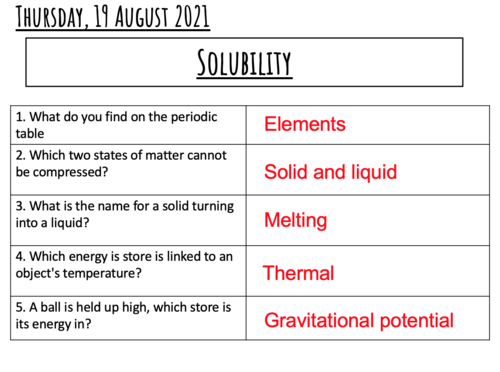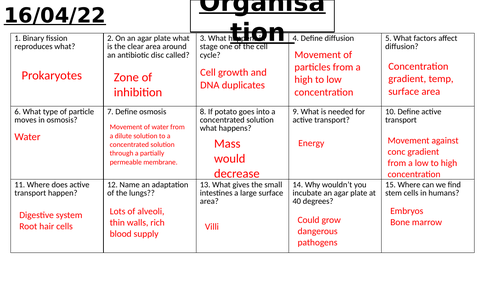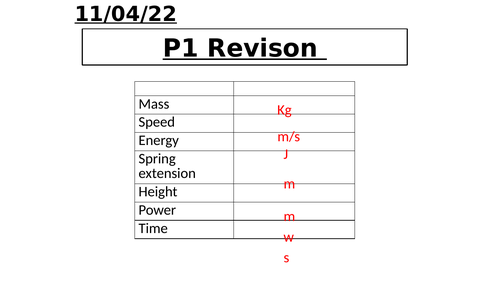
123Uploads
29k+Views
8k+Downloads
All resources

B1.2 Animal and plant cells
Aimed at a mixed ability year 9 class
Starter: identify which cell is a plant cell and which is an animal cell and explain why
Main: Label plant and animal cells differentiated worksheets (bronze silver gold)
Match up strucutre and function of organelles
venn diagram similarities and differences between plant and animal cells
Plenary: true/false questions

B1.5 specialisation in plant cells
Aimed at a mixed ability year 9 class
Starter: recap draw and label plant cell. Stretch, describe the role of each organelle
Main: Discuss where the palaside cells are found, discuss why they are adapted for their function being here
research task: HA/LA versions find out about root hair cells, xylem, phloem
Exam questions
Plenary: mark exam questions

B1.4 Specialised animal cells
Aimed at a mixed ability year 9 class
Starter: why do animals have specialised cells, try and identify cells in the pictures
Main: Research task - using kerboodle books or any other resource, research criteria to meet for each cell.
Lower ability information sheets, and grid to fill in for LA students
Extension: answer questions
Plenary: identify if statements are true/ false

B1.6 Diffusion
Aimed at a mixed ability year 9 class
Starter: how do sharks find their prey easily
define diffusion
Main:: three practicals
affect of temperature
affect of concentration
affect of surface area
accompanying work sheet to fill in whilst completing practical
THen complete differentiated diffusion literacy task
Plenary: tweet what they have learnt today

B1.8 Osmosis in plants
Aimed at a mixed ability year 9 class
Starter: what is the role of a vacuole
stretch: what happens to a plant cell if placed in concentrated sugar solution
Main: Complete required practical, record results, compelte worksheet
extension exam question if do complete
Plenary: mark required practical

B1.9 active transport
Aimed at a mixed ability year 9 class
Starter: what would happen to the particles thinking about diffusions
Main: introduce active transport, define active transport. show where it works in plants and animal cells
complete differentiated literacy activity
Extension task
Plenary: mark work, tweet one thing they have learnt today

B2.1 Cell division
Aimed at a mixed ability year 9 class
Starter: match up the key words to the defintions
Main: discuss key words and then think pair share, how do we go from a single cell to an embryo to who we are today
Research mitosis, move around the room and find out about the steps
Complete literacy question task to reinforce learning for the day
Plenary: go through answers to the worksheet and tweet the most important thing they have learnt today

B2.3 stem cells
aimed at a mixed ability year 9 class - worksheet from tes
Starter
What is a stem cell. Turn the picture into words – looking for key words, undifferentiated, differentiated
Main –
Watch a video, explaining what stem cells are and what they can be used for
Research task, differentiated criteria to find out about stem cells use p.30-31 in kerboodle text books, ipads
extension: worksheet with questions
Plenary
Peer assess each others work, which level do they think their partner has achieved, using the success criteria

B2.2 Growth and division
Aimed at a mixed ability year 9 class
Could do the practical - but where it falls with teaching my class this im unable to, task to use the method instead
Starter: Students discuss how cells change through the life time of a human
Go through what happens at each stage in life, students then write their own description in their books of what happens at each stage
Stretch: if cells are repaired and replaced and there are stem cells how are people paralysed
Main –
Discuss how plants grow – key words on the board, from discussion get students to write their own definitons for these words, green pen their answers
Turn method for how to clone cauliflower into a storyboard – alternatively you can carry out the practical.
Extension questions if students finish task
Plenary
Explain why a starfish is more like a plant than an animal in terms of its ability to regrow limbs

C1.2 Separating mixtures
Aimed at a mixed ability year 9 class
starter:
Differentiated starter task from previous learning. Bronze = level 4 silver – level 6 gold = level 8 (to be gaining a level 8 answer needs to be really detailed) students have done this at KS3
Go through and green pen answers
Main
Talk about safety for the practical, demo practical with distillation to get pure water
Students carry out rock salt practical to get salt
Answer questions when done, extension question available also
Plenary
5 mins
Identify the three processes we have learnt about today
Homework - differentiated
Summary sheet on separation techniques

C1.7 Ions, atoms and isotopes
aimed at mixed ability year 9 class
Starter Activity
Differentiated Bronze/silver/gold questions from previous lesson
Main –
Think, pair, share – how big is an atom. Copy down the size of an atom and nucleus intho their books
Copy key words need to be able to define ion and isoptope for level 4
Explain that atoms can lose or gain electrons. And what happens if they do. Students make notes on this, then go through a few examples.
Students practice working out electron/proton/neutron for ions
Extension task for students who finish
Explain what an isotope is, do one worked example of finding proton/neutron numbers then their go at finding how many protons and neutrons are in carbon isotopes
Exam practice if time
Plenary
Identify whether the pictures are atoms, ions or isotopes

C1.1 History of the atom
Aimed at a mixed ability year 9 class
Starter Activity
Draw and label the atom – discuss that its changed over time
Main –
Watch video of history of the atom – try and list the scientists and their discoveries
Use textbooks or ipads to research the history of the atom and fill in the timeline. Differentiated version, blank version for HA students and LA version with question prompts
Extension fill in the gaps sheet
Plenary
Draw the current atom from memory and label it

C1. 8 electronic structures
Aimed at a mixed ability year 9 class
Starter Activity
Exam question starter – go through and green pen
Main –
Recap where to find the number of electrons an atom has, go through electronic structure rules. Do a few examples on the board
Two worksheets – first worksheet students need to find out the number of protons, neutrons and electrons each element has, the second they need to draw the electronic structures
Extension: explain why sodium and lithium might react in a similar way
Write a step by step guide for somebody to explain how you draw electronic structures
Plenary
Exam question plenary – spot mistakes in the electronic structures

Mixtures
Suitable for KS3
Includes
Recall starter
Element mixture or compound particle diagrams and task
Mini demo or practical to show how we can separate mixtures
Written task to explain how properties can help us separate mixture
Peer assessment grid
recall plenary

Solubility KS3
Suitable for year 7/8
Recall starter
Followed by explaination and practice of the new keywords solute/solvent/solution
Questions and tasks provided with answers
mini practical to do with solubility, does it dissolve or not?
Questions for follow up to the practical
Recall plenary

C3 Quantitative chemistry tutoring
A tutoring powerpoint I used does not include percentage yield.
Comes with a key question document and exam questions.
All answers to powerpoint included as animations or in the notes below

KS3 investigating solubility
Lesson includes a practical to investigate how temperature affects solubility.
Comes with an optional work sheet.

